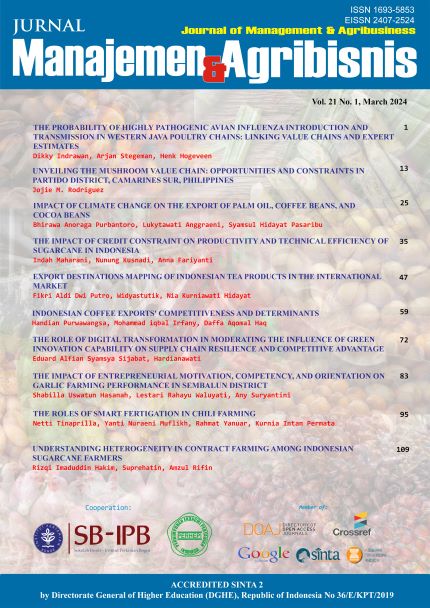Unveiling The Mushroom Value Chain: Opportunities and Constraints in Partido District, Camarines Sur, Philippines
Abstract
The agribusiness sector in the Philippines faces costs, productivity, and crop yield challenges, with a persistent focus on traditional crops despite evidence supporting the potential of high-value crops. The objectives include identifying key actors, analyzing costs and returns at each stage, and uncovering constraints and opportunities within the mushroom value chain. A comprehensive methodology involving key informant interviews, focus group discussions, observations, and document reviews was employed to collect primary data from various stakeholders. The study reveals the diverse channels in the mushroom value chain, including direct sales to consumers, processing by farmers, and engagement with intermediaries like wholesalers. The value chain map visually depicts these relationships and interactions. Results highlight the roles of different actors, such as mushroom farmers, middlemen, retailers, and processors. The processor, often a farmer, emerges as the most profitable, benefiting from processed mushroom products with an extended shelf life. The study calculates the net profit margin for each actor, revealing the financial dynamics across the value chain. The study also discusses the constraints and opportunities faced by various value chain actors and concludes with policy recommendations to enhance the development of mushroom production in the district. Agribusiness managers can leverage the insights from this study to make informed decisions, develop strategic plans, and implement initiatives that capitalize on the oyster mushroom value chain's untapped potential, contributing to the agricultural sector's overall development in the Partido District and beyond.
Keywords: mushroom, oyster mushroom, value chain analysis, supply chain analysis
Authors
Authors who publish with this journal agree to the following terms:
- Authors retain copyright and grant the journal right of first publication with the work simultaneously licensed under a Creative Commons Attribution License that allows others to share the work with an acknowledgement of the work's authorship and initial publication in this journal.
- Authors are able to enter into separate, additional contractual arrangements for the non-exclusive distribution of the journal's published version of the work (e.g., post it to an institutional repository or publish it in a book), with an acknowledgement of its initial publication in this journal.
- Authors are permitted and encouraged to post their work online (e.g., in institutional repositories or on their website) prior to and during the submission process, as it can lead to productive exchanges, as well as earlier and greater citation of published work (See The Effect of Open Access).

